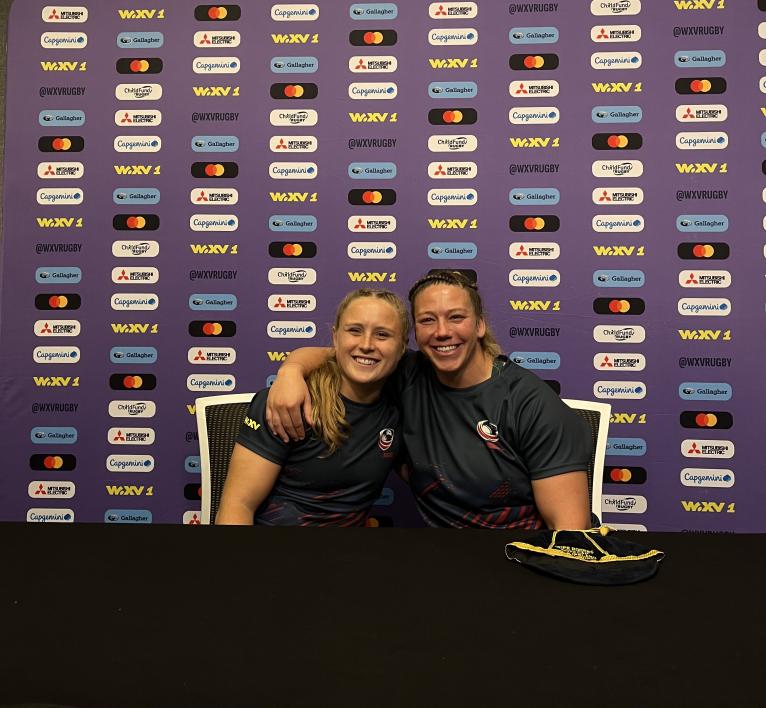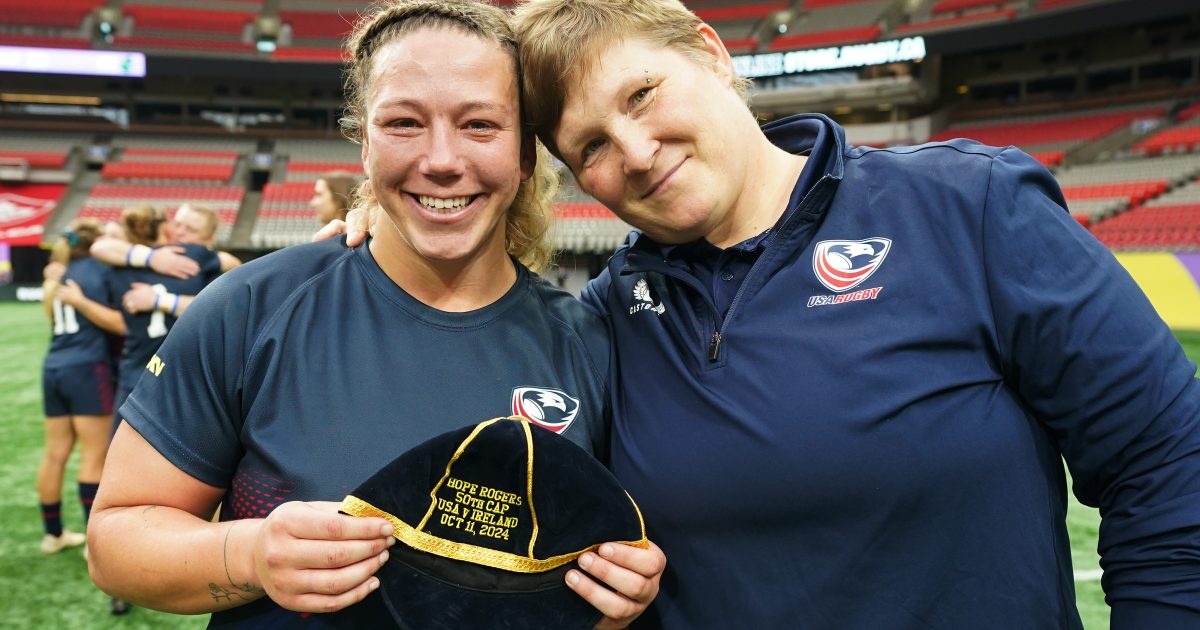A tribute to the USA’s number one: ‘Hope Rogers is a standard-bearer’

In the USA’s last match of this year’s WXV 1, prop Hope Rogers made history as the second woman to reach 50 caps for the national team.
After making her debut against France in 2013, over a decade of tireless commitment to USA rugby has contributed to the milestone, which has taken her within one cap of becoming the equal most-capped Women’s Eagle.
The occasion was made more special by the fact that Jamie Burke, the first woman to reach 50 caps for the USA and currently most-capped player with 51, was there to present Rogers with her starting shirt and 50th cap.
Burke is not only a trailblazer in USA rugby and the wider women’s game, but also someone who Rogers considers a guiding light.
“I’ve looked up to Jamie ever since I started playing rugby,” she begins, starting to well up as she reflects on the impact her former teammate has had on her life and career.
“I got my first cap in 2013, and in 2014 at the World Cup when Jamie had hit her 51 and retired, she gave me a hug and there’s a really cool photo that we have of it that I have on my fridge. She said, ‘You’re next’. I didn’t take that lightly.
“USA Rugby has been a home to me, it’s definitely been family. I know that’s a cliche, but I have found a home within the team which has meant a lot to me. I think when she said those words to me it was just to keep building the jersey the best I can, to help build the team the best I can. I’m really happy with the team we have now because it’s really special.”
ADVERTISEMENT
View this post on Instagram
The ever self-effacing prop who plays her club rugby for Exeter Chiefs in the Premiership Women’s Rugby league went on to explain what the milestone means to her.
“I think it’s significant just in that not a lot of people have done it in the USA, there’s only been one other person, Jamie Burke, to have done it. What feels significant about it is the excitement that so many Eagles are behind me with how World Rugby has pushed women’s rugby forward and how many more Eagles are going to be hitting the 50.”
Increased international competition is often a benefit of WXV that is lauded by players and coaches alike, but the resulting impact is the stepping stone in allowing players to break new ground when it comes to milestones.
“We have two Eagles in their 40s [caps] and we had a few just hit 30 and I think next year the goal is to play about 10 games which is maybe the most we’ve ever played within USA rugby. I’m really excited to see how many Eagles are starting to hit not only 50, but 60, 70, 80 even 100 can be hit with some of our younger Eagles.
“That’s what we want with women’s rugby as a whole, growing the sport, growing the game, especially on the women’s side.”
Despite a winless first foray in WXV 1, Penn State University educated Rogers was positive about where the team are at now, and where they hope to be.
“It’s definitely been a wild journey I would say. We’ve had different coaches in and out, there was a pandemic, just how the game has changed. I guess I would say in all of it it’s felt like a build.
“We’ve had really good moments, we ranked fourth in the 2017 World Cup, we kind of had a dip from there with the pandemic and we had a few coach turnovers,” the 31-year-old, who has played in three Rugby World Cups to date, explained.
“What I’m really excited about and what I feel really positive about, and I keep saying it, is where we are now as a team. It’s really exciting what we’re building, and how far we’ve come in the last year. I said it in our huddle the other day, we were really satisfied a bit ago to be competing with the best teams in the world, but we’re not satisfied with that anymore.
“We are one of the best teams in the world and we want to keep showing the world that. It’s going to be important that we start making those statements and finishing games out. I think that’s what’s exciting for the team we have.”
USA Women’s Eagles’ most-capped player Burke made the journey to Vancouver to witness the occasion for Rogers, something she has had her eye on since the start of the season.
“I have been keeping an eye on the cap tally for several years and as the schedule for this year, I started thinking about all of my travel plans that I would make depending on how rosters went, because I would not have missed it for the world.
“I was there for her first cap, she was there for my last cap. Being a part of her journey has been such an incredible blessing for me to have her both as a teammate and a player I coached and as a friend,” said Burke, who amassed 51 caps between 2004 and 2014.
View this post on Instagram
As Rogers alluded to, every player who reaches the half-century cap mark signifies the growth of the women’s game in the USA.
Burke spent ten years as the only woman to have reached and surpassed the 50-cap mark, and was over the moon to not only have Rogers join her, but at the prospect of many others reaching the same point and beyond.
“I said when I got my 50th cap that I would not be the last and that I was looking forward to not being lonely up there because it would mean that USA rugby and the women’s programme was growing and we were increasing the number of competitive matches we were playing,” Burke explained.
“I’m excited because she is the next one, but I anticipate a number of additional folks over the coming couple of years adding into that group, and that’s so exciting for what it means for the USA women’s rugby programme.”
Rogers is synonymous with the growth of the Women’s Eagles and the women’s game.
“Hope is a standard-bearer. When you watch her play, she is still one of the most dominant players on the entire world stage. She sets the marker of what it looks like to be a USA rugby player” Burke said.
“Those young players can look at that role model and say, okay, if I’m an Eagle, this is what it looks like, this is what I have to aspire to be, this is how I have to work and how I have to carry myself. I think that she really sets that standard.”
The impact Rogers has had on the USA programme over the past 11 years is evident, with present players also readily extolling her virtues.
Cassidy Bargell, the 24-year-old scrum-half who made her first start in the same match that Rogers won her 50th cap, was sat beside the most recent player to reach the half-century milestone during post-match media duties.
Before our interview starts, Rogers happily discloses that her and Bargell are 100 cap numbers apart, a special link between the two who made their first appearances for the USA over ten years apart.
“Hope is one of the easiest people to look up to. She’s so easy to follow. She’s such a hard worker and a natural leader,” Bargell begins.

“Everything she does is amazing and she pushes everyone in training to be the best version of themselves and is constantly bringing out the best in other people and yet is so humble. I can’t say enough good things about Hope and how easy it is to look up to her and how much we want to work hard to make her proud. To share the field with her has been the best thing ever,” she adds with a smile.
Seeing newer Eagles flourishing and sharing the learnings she’s made throughout her journey is something that seems to truly delight Rogers, she lights up when discussing seeing the next generation grow.
Performance-wise, Rogers is up there as one of the best in the world, but her commitment to developing the legacy of USA rugby epitomises what makes her not only a world-class player, but a world-class person as well.
“I consider myself a bit of a caretaker. I’m a teacher as well. I love seeing the young props and like Cass being here, having her first start. We’re 100 Eagles apart so it’s really cool to see them growing. It’s really inspiring to see their work rate and how talented they are at such a young age. My job is I want to impart as much knowledge as I can,” Rogers said.
“I’m not going to be in the game much longer, maybe we’ll see how much more I can get out of this old body but I’m really excited to teach and impart all of the knowledge that I can because it’s really about the legacy and building the jersey the best you can for the team that’s about come.”
Head coach Sione Fukofuka, who joined USA Rugby from Rugby Australia in November 2023, had abundant praise for Rogers.
“If I had 15 Hope Rogers, we would be world number one,” he said. “She is a role model, she’s a testament to resilience, but she’s also extremely skilful. You’ll see that every impact that she has is a positive one, she goes forwards.
“Alongside some of the other senior members, Kate [Zackary], Rachel [Johnson] and a number of others, our young squad that we’re building is built around the foundations that they set.
“Hope is at the forefront of that and it’s been a pleasure to come into this role and have the opportunity to coach her.”
Captain Kate Zackary also reminisced on the shared experiences she’s had with Rogers over the course of her career so far, and considered the impact that the prop has not only on those around her, but on a far wider scale.
“I’ve played with Hope now ever since I debuted in 2016, she’s been around since 2013. We even had a stint in sevens together, I don’t know how many people remember that, but Hope even played USA sevens. We talked a lot in our jersey ceremony about how she’s changed the game of what a prop looks like,” the Trailfinders player said.
“She’s dynamic, she’s got great footwork, she’s got pace, but then she can scrummage, she can set-piece, she can do the hard graft that you want from a prop but she can also play make, sometimes like a centre! It’s great to have someone like that, and having her at the forefront of changing the game.
“You’re seeing props not just in our own country but around the world aspiring to play how Hope does. She’s a game changer, not just for us but for the game of rugby.”
The USA’s rich history in women’s rugby continues to write new chapters, and the first-ever country to win the Women’s Rugby World Cup in 1991 will kick off the 2025 Women’s Rugby World Cup against England, who they faced in the first two RWC finals.
If named in the squad, Rogers, who by then may have achieved the most caps in USA Women’s Eagles history, could feature in her fourth RWC.





































































